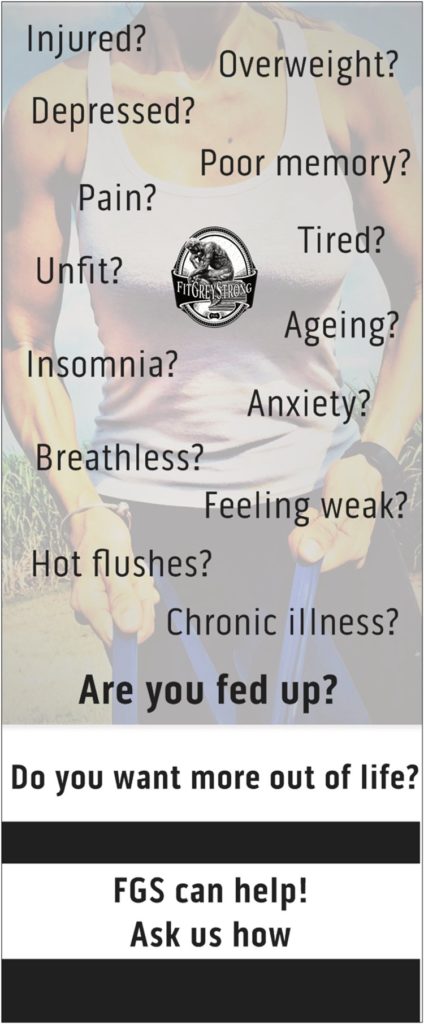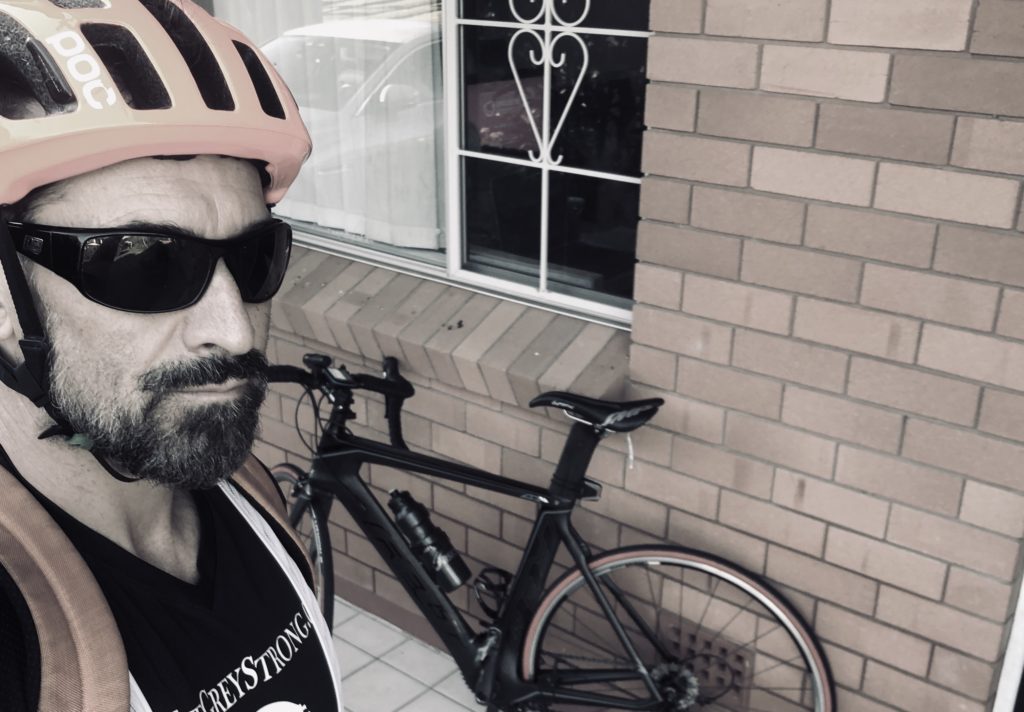No, you will not “bulk up” if you lift weights 😉
Category Archives: Exercise Physiology
FitGreyStrong Services
FitGreyStrong (FGS) provides consultative expertise based on the latest scientific evidence for:
- Exercise Physiology services
- Strength & Conditioning programs
- Personal Training sessions
There are a variety of exercise programs available to cater to a wide range of specific individual needs and considerations. Improvements in health, fitness, strength, physical function, quality of life whilst reducing the chances of, or mitigating the worsening of chronic disease/illness, are at the cornerstone of our interventions.

For those living in Townsville and seeking private services, please contact us for more information on how to get started. As a general guide, our fees for services are charged pro-rata (GST inclusive) and would involve an initial consultation, functional and physical fitness assessment, design of a customised individual program, and personal supervised training sessions as determined to suit the needs/wants/medical and health considerations of the individual.
- An initial consultation will take between 30-60 minutes and is largely determined by how complex the case is.
- Prior to an initial consultation some forms that are downloadable are required to be filled out which provide background to how best help someone (to access these forms click here). In most cases, only forms 1, 2 and 4 need completing.
- Following an initial consultation, a functional and physical fitness assessment would be booked and completed which would take between 30-60 minutes.
- With this information a customised individual program is then constructed which takes between 45 minutes to 3 hours to devise and finalise. A number of factors influence the length of time that a program takes to put together but 90 minutes is the average time for this to be completed.
- Following the initial consultation, FGS will advise how long the program design component will take and base our quote off this assessment.
- The last phase is the practical aspect where 1 hour is allocated to be shown through the program and the FITT principles (program parameters of frequency, intensity, time, type etc) explained.
- From here there is then the option of doing this as a home-based program or at a facility of your choosing (some people already have a gym that they frequent) and/or doing personal supervised training sessions (30, 45 or 60 minutes) every week, fortnight or at a frequency deemed appropriate and in line with the personal objectives that have been discussed.
- If there is the need to have closer supervision during the first few months, FGS will advise and recommend as needed.
Health rebates, such as Medicare, workers compensation (WorkCover) and private health funds are available for those that qualify. For further information regarding these please contact us directly or discuss further with your GP or Specialist.
For all those living in other Australia states or living outside Australia please see here or to discuss how to get started, please contact FitGreyStrong via the ‘contact us’ form on the home page or you can email FitGreyStrong@outlook.com
How exercise helped save me from a very dark place
As I lay on my sister-in-law’s rug in our temporary rental house after losing so much in the 2019 Townsville flood, I had a light-bulb moment following an intense road cycling ride. The insight was, basically, that it is extremely difficult for the neurocircuitry of the brain to remain “mood altered” towards a “depressive state” embodied by stress and anxiety immediately following very hard exercise. In other words, challenging exercise profoundly affects our emotional state and as I lay on that rug, my heart still pounding, my muscles still aching and my body still sweating, try as I might, I could “find” no trace of the trauma, stress, anxiety or depressive symptoms that were there 60 minutes beforehand. Of course, I knew that these feelings had not magically disappeared and would rear their ugly head again, but the temporary relief was pure bliss and, if anything, had injected some well needed hope where there had been very little before. The experience spurred me on to seek “treatment” through exercise.
Apart from losing a loved one, there is perhaps no greater tragedy than losing one’s home. The home for all intents and purposes is the foundation and place where your life is lived with those you cherish and love most dearly. It is where your goals and dreams are made. It is where you feel most secure and safe. It is where you laugh, cry, shout and smile. Your home is literally an extension of who your are as a person, who your family is. It is where you watch and participate in the most astonishing journey of change and development in each person, in each relationship and in the family as a whole. It is where you nurture and reaffirm old friendships and where you forge new ones. It is where you celebrate birthdays, Christmas and Easter. It is where we have great dinner parties and where we watch great movies and squirm through tactless reality TV shows. Home is so many things to us that it is difficult to describe them all but it certainly was where I was most comfortable and where I could be “myself”. Now it is gone and that’s very difficult to believe, deal with, accept. It leaves you feeling lost, displaced, uncertain, angry, sad, frustrated. It makes you wonder why? The effects of such an experience are so overwhelming, surreal almost and take a significant toll on your physical and mental health. It can leave you in a very dark place and I can honestly say that after the initial massive rush of adrenaline that comes when the waters recede and the clean up starts and comes to an end, I was heading toward that very dark place.
(Going in to our house hours before the major flood; it was to rise another 40 cm)

As an Exercise Physiologist and Scientist, and having worked extensively in the neuroscience, Psychiatry and mental health field for 15 years, I was acutely aware of the importance and significant positive effect exercise and a physically active lifestyle can have on mental health. There are many studies now to demonstrate that, no matter what the problem, exercise has a critical role to play and should……no, must be included in an overall treatment plan. In fact, a recent book published titled “Exercise based interventions for mental illness: Physical activity as part of clinical treatment” which reviewed 100s of studies in this area, lays out how exercise and a non-sedentary lifestyle helps dramatically improve treatment outcomes, physically, emotionally and mentally. Those suffering from depression, anxiety- and stress-related disorders, including generalised anxiety disorder (GAD), social anxiety disorder (SAD), obsessive-compulsive disorder (OCD), panic disorder (PD), posttraumatic stress disorder (PTSD), bipolar disorder (BD), schizophrenia and alcohol use disorders all have so much to gain from exercise and increased general physical activity.
All that knowledge and experience in this field was finally put to the quintessential test. After waking one morning, several weeks after our home was devastated, our lives shattered, I lay in bed and just couldn’t get up. What was there to get up for? I had disengaged from everything, wasn’t exercising, was having a couple of glasses of wine every night, was eating crap and wasn’t sleeping very well. I was pretty much at a point that if something didn’t change, I was in big trouble. I struggled out of bed and sat dejected in the lounge room of our rental and looked at my wife, Sandy, and just shook my head and said: “I can’t do this, it’s too hard”. I realised that I would need to take some control back and made the decision, then and there, to put in place what I knew was instrumental for good overall health. That meant, what is in my opinion so important for all of us, getting to bed early and focusing, prioritising on getting a good night’s sleep. It meant no more reaching for the bottle of red to numb the pain. It meant focusing on eating well. It meant reaching out and seeking some counselling. And, what I believe now helped me no end, ensuring I regularly exercised and on occasion, very intensely.

On that fateful morning after sitting on the lounge totally despondent and in despair, and deciding that I needed to change because I couldn’t change what had happened, I “coerced” my way into my cycling kit, put my socks and cycling shoes on, my helmet, had my coffee, pumped the tyres up, dusted off my road bike, clicked my feet into the pedals and headed down the road. For the next 10 minutes, I battled with the urge to turn around, go home and go back to bed. But what would that achieve? I’d been there, done that. It wasn’t helping in any way – getting “more rest” – so I pushed on. It was in the next 15 minutes that I realised that it was the first time since the flood that I felt “released” from all the shit, the heartache, the frustration, the anger, the lethargy, the anguish. There was a feeling of dissipation of all of the negativity which makes you feel so awful. The exercise had quite literally expunged the very essence of all that was bad.
The day I decided to make these changes was the day my whole attitude changed. Once I made the change, had a plan, followed it and acted on it, I now gained some control. It is the loss of control over our circumstances that many of us struggle with. Recovery requires that we have control over something. Whatever that something is, I would implore that it be something that you perceive is helping you move forward and preferably, something that is going to enhance your overall health and wellbeing rather than detract from it. Exercise certainly qualifies as one such thing and I would indeed strongly contend, is one of the most important lifestyle behaviours that can dramatically influence overall health, particularly our mental health.
To find out more contact FitGreyStrong@outlook.com or phone 0499 846 955 for a confidential discussion. Act now and take back control.
Disclaimer: All contents of the FitGreyStrong website/blog are provided for information and education purposes only. Those interested in making changes to their exercise, lifestyle, dietary, supplement or medication regimens should consult a relevantly qualified and competent health care professional. Those who decide to apply or implement any of the information, advice, and/or recommendations on this website do so knowingly and at their own risk. The owner and any contributors to this site accept no responsibility or liability whatsoever for any harm caused, real or imagined, from the use or distribution of information found at FitGreyStrong. Please leave this site immediately if you, the reader, find any of these conditions not acceptable.
© FitGreyStrong
Resistance Training Alters The Trajectory Of Ageing
Recently I published an article on my website titled:
“Strength training can alter the trajectory of ageing”.
After receiving feedback from some of those who regularly visit my website and social media channels, there were some suggestions to provide a summarised or bottom-line version of some of my articles for those that are looking for something that gets straight to the point. So here it is. The short version of the abovementioned article.
The research paper that everyone should read
The year was 1990 and researchers Maria Fiatarone and colleagues published their findings in The Journal of the American Medical Association after undertaking a study to determine the feasibility and the physiological consequences of high-resistance strength training in the frail elderly. These participants were very frail, had an average age over 90, suffered many co-morbidities and were basically not in very good condition. Their muscles were very atrophied, functional capacity was very poor and their physical movements were very slow.
After 8 weeks of progressive resistance training that only utilised one exercise that focused exclusively on the quadricep (thigh) muscles, the results were totally unexpected. Gains in muscle strength were impressive averaging over 170%, with some subjects making extraordinary gains of almost 400%. There was an accompanying increase is muscle size of over 10% as assessed by CT scans. Functional mobility accompanied the improvements in strength and muscle hypertrophy (growth). The time taken to complete the walking test improved substantially from 44 seconds to 29 seconds representing a 48% improvement. Two subjects no longer needed canes to walk at the end of the study and one of three subjects who could not initially rise from a chair without the use of their arms became able to do so. These physiological and functional changes were truly incredible.
What is clear is that the preservation of fat-free mass (muscle) as one ages is a critical factor and directly affects muscle strength in the older person.
Exercise and resistance training specifically, is able to provide the neuromuscular system the appropriate physiological stimulus to reverse and modify a portion of the muscle weakness often and simply put down to old age.
Re-read that sentence because this is huge! So off you go and start lifting.
For the longer version please see here.
Disclaimer: All contents of the FitGreyStrong website/blog are provided for information and education purposes only. Those interested in making changes to their exercise, lifestyle, dietary, supplement or medication regimens should consult a relevantly qualified and competent health care professional. Those who decide to apply or implement any of the information, advice, and/or recommendations on this website do so knowingly and at their own risk. The owner and any contributors to this site accept no responsibility or liability whatsoever for any harm caused, real or imagined, from the use or distribution of information found at FitGreyStrong. Please leave this site immediately if you, the reader, find any of these conditions not acceptable.
© FitGreyStrong


